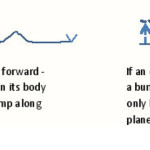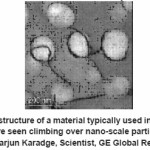Ram Oruganti
Senior Scientist, GE Global Research, Bangalore, India.
DOI : http://dx.doi.org/10.13005/msri/090125
Article Publishing History
Article Received on : 15 Apr 2012
Article Accepted on : 20 May 2012
Article Published :
Plagiarism Check: No
Article Metrics
ABSTRACT:
When a material is subjected to temperature and stress, it deforms slowly resulting in permanent shape change. If the same amount of stress were applied at room temperature, the material would not budge. This deformation at high temperature under low stresses is called creep. This phenomenon is important for OEM’S like GE etc. since turbine components are exposed to low stress and high temperature and the resulting shape change is not a desirable consequence. Apart from the change in shape, the components can eventually rupture leading to catastrophic consequences. So it is imperative that the nature of this phenomenon is understood well. Some of the questions to be answered are 1) What makes one material more resistant to creep that the other 2) How can a material’s creep resistance be improved 3) How can the current creep damage in a component be measured 4) Is it possible to say what fraction of the total life of a component has been consumed by creep.
KEYWORDS:
Material design; Creep
Copy the following to cite this article:
Oruganti R. Creep and Material Design. Mat.Sci.Res.India;9(1)
|
Introduction
So what makes a material deform at high temperature, but not at room temperature? To understand that we first need to understand how a metal deforms in the first place. What makes metals ‘ductile’? The answer to this question can very easily be visualized by examining how a caterpillar moves. As we all know, a caterpillar first creates a bump in its body and then moves the bump (shown schematically in Figure 1). This requires far less energy than dragging along its entire body over the ground, not to speak of all the bruising that would result. The movement of multiple bumps will ensure that the caterpillar moves along at a steady pace. This type of movement is exactly what happens in a metal when it is deformed. ‘Bumps’ in the internal atomic structure of the metal allow the metal to ‘deform’. Such bumps are called dislocations. Figure 2 is a picture of the internal structure of a metallic alloy (one typically used in turbines) showing dislocations – the black lines are dislocations whose movement makes a material deform. When there are obstacles in the path of these dislocations, the latter simply bow around them or cut through them. As you can clearly see, the more the obstacles in a material, the stronger it is since the dislocations are not going to have an easy time going through the forest of obstacles. But this will work only if the stress is sufficient for the dislocations to bow or cut. What if the stress is too low, such as usually the case is during creep? How does the material deform? The answer to this question lies at the heart of creep and leads to some interesting questions.
Figure 1:
Figure 2: Picture of the internal structure of a material typically used in power generation equipment. Dislocations are seen climbing over nano-scale particles. Courtesy –Mallikarjun Karadge, Scientist, GE Global Research
Many researchers have hypothesized that when the dislocation encounters an obstacle when the stress is too low, but the temperature is high enough, the former ‘climbs’ over the obstacle! In order to understand this, let us go back to the case of the caterpillar. If during the process of moving, an obstacle suddenly materializes underneath the hump, the only way for the caterpillar to continue its motion is to raise itself somehow to the level of the upper edge of the obstacle. In other words, it has to climb and adopt a plane of motion that makes the obstacle irrelevant. This is exactly what the dislocation is hypothesized to do – it raises itself such that it can continue to move. The energy for raising itself comes from the thermal energy. The dislocations in Figure 2 are actually climbing over the particles (the white patches). One of the implications of this ‘theory’ for material design is that more obstacles usually results in more strength. Another is that if the obstacle is able to somehow attract the dislocation (think about a yummy edible treat for the caterpillar) then the dislocation would not like to move from the obstacle. This too is a possible mechanism that can strengthen the material against creep. These general principles have been used by metallurgists over the past decades to invent alloys that are truly wonderful in terms of their ability to resist creep deformation in the hottest sections of a turbine (where temperature can go as high as 1000 degree centigrade).
While such advancements have helped make turbines what they are currently, scientists are now being asked to extract more performance from turbines and consequently from the materials that go into making them. Current research on creep of metals (and deformation in general) is therefore focused on understanding more fine details of the movement of dislocations and their interaction with obstacles. For instance, materials scientists at industrial and university laboratories are using advanced characterization and modeling techniques to understand how various alloying elements influence dislocation motion. Such detailed understanding is expected to lead to better alloys that can allow turbines to operate at high temperatures and for longer times. Another problem that is being addressed currently is that most parts that are currently in service are overdesigned – in other words, they could be used for much longer than what the designers originally thought possible. But a prerequisite to making parts operate longer is, again, a thorough understanding of their inner workings and how life gets consumed. This is very similar to the study of ageing in humans. Genetic research carried out over the past few decades has revealed that cell aging is programmed through what are called telomeres. Therefore current genetic research is focused on understanding the nature of these telomeres and whether they can be modified in some fashion to prolong human life. Materials research is proceeding along similar lines and many researchers are engaged in understanding what the basic building blocks of material behavior are – in other words, is there a material genome!
References
- R. Oruganti, “A new approach to dislocation creep”, Accepted for publication in Acta Materiali
- R.K. Oruganti, Srinidhi Sampath and Sundar Amancherla, “On the Arzt-Rosler-Wilkinson model for detachment controlled creep”, Scripta Materialia, 52: 323-327 (2005).
CrossRef
- R.K. Oruganti, M. Karadge and S. Swaminathan, “Damage mechanics based creep model for 9-10% Cr Ferritic Steels”,Acta Materialia, 59: 2145-2155 (2011).
CrossRef
- R.K. Oruganti and A.K. Ghosh, “Fabrication and properties of superalloy-zirconia composites”, Metallurgical Transactions, 34:2643-2653 (2003).
CrossRef
- R.K.Orugant and A.K. Ghosh, “FEM analysis of transverse creep in honeycomb strcutures”, Acta Materialia, 56: 726-735(2008).
CrossRef

This work is licensed under a Creative Commons Attribution 4.0 International License.
 Material Science Research India An International Peer Reviewed Research Journal
Material Science Research India An International Peer Reviewed Research Journal




